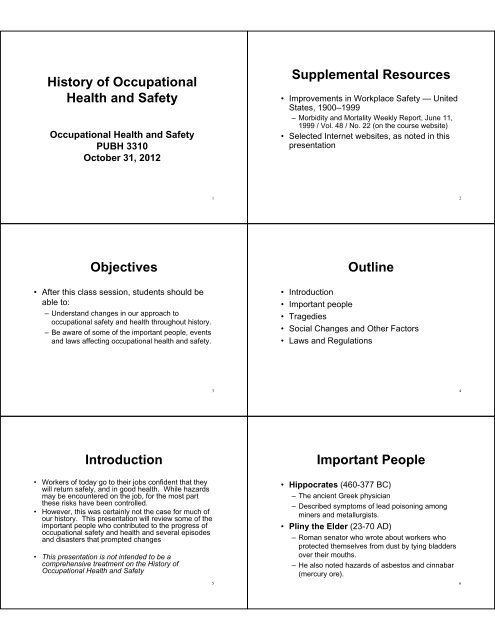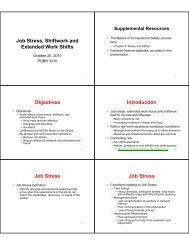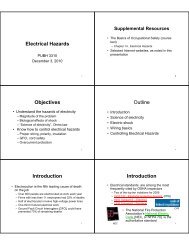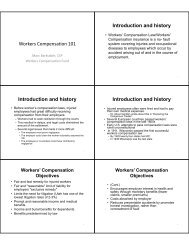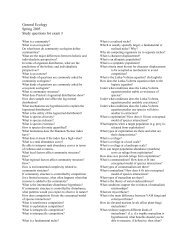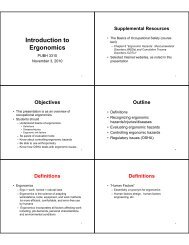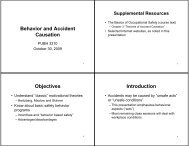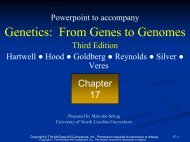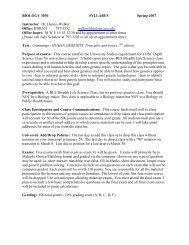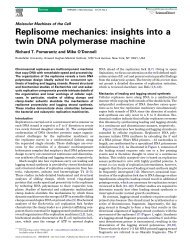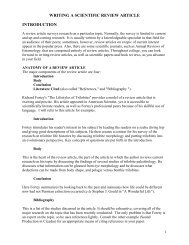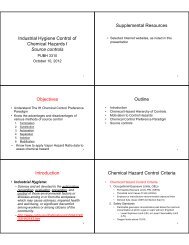History of Occupational Health and Safety Supplemental Resources ...
History of Occupational Health and Safety Supplemental Resources ...
History of Occupational Health and Safety Supplemental Resources ...
You also want an ePaper? Increase the reach of your titles
YUMPU automatically turns print PDFs into web optimized ePapers that Google loves.
<strong>History</strong> <strong>of</strong> <strong>Occupational</strong><br />
<strong>Health</strong> <strong>and</strong> <strong>Safety</strong><br />
<strong>Occupational</strong> <strong>Health</strong> <strong>and</strong> <strong>Safety</strong><br />
PUBH 3310<br />
October 31, 2012<br />
<strong>Supplemental</strong> <strong>Resources</strong><br />
• Improvements in Workplace <strong>Safety</strong> — United<br />
States, 1900–1999<br />
– Morbidity <strong>and</strong> Mortality Weekly Report, June 11,<br />
1999 / Vol. 48 / No. 22 (on the course website)<br />
• Selected Internet websites, as noted in this<br />
presentation<br />
1<br />
2<br />
Objectives<br />
• After this class session, students should be<br />
able to:<br />
– Underst<strong>and</strong> changes in our approach to<br />
occupational safety <strong>and</strong> health throughout history.<br />
– Be aware <strong>of</strong> some <strong>of</strong> the important people, events<br />
<strong>and</strong> laws affecting occupational health <strong>and</strong> safety.<br />
Outline<br />
• Introduction<br />
• Important people<br />
• Tragedies<br />
• Social Changes <strong>and</strong> Other Factors<br />
• Laws <strong>and</strong> Regulations<br />
3<br />
4<br />
Introduction<br />
Important People<br />
• Workers <strong>of</strong> today go to their jobs confident that they<br />
will return safely, <strong>and</strong> in good health. While hazards<br />
may be encountered on the job, for the most part<br />
these risks have been controlled.<br />
• However, this was certainly not the case for much <strong>of</strong><br />
our history. This presentation will review some <strong>of</strong> the<br />
important people who contributed to the progress <strong>of</strong><br />
occupational safety <strong>and</strong> health <strong>and</strong> several episodes<br />
<strong>and</strong> disasters that prompted changes<br />
• This presentation is not intended to be a<br />
comprehensive treatment on the <strong>History</strong> <strong>of</strong><br />
<strong>Occupational</strong> <strong>Health</strong> <strong>and</strong> <strong>Safety</strong><br />
5<br />
• Hippocrates (460-377 BC)<br />
– The ancient Greek physician<br />
– Described symptoms <strong>of</strong> lead poisoning among<br />
miners <strong>and</strong> metallurgists.<br />
• Pliny the Elder (23-70 AD)<br />
– Roman senator who wrote about workers who<br />
protected themselves from dust by tying bladders<br />
over their mouths.<br />
– He also noted hazards <strong>of</strong> asbestos <strong>and</strong> cinnabar<br />
(mercury ore).<br />
6
Important People<br />
Important People<br />
• Ulrich Ellenborg (1473)<br />
– A German physician, he recognized the dangers<br />
<strong>of</strong> metal fumes, described symptoms <strong>and</strong><br />
preventive measures.<br />
7<br />
• Paracelsus (1493-1541)<br />
– Known by several names<br />
• Born Phillip von Hohenheim<br />
• Theophrastus Philippus Aureolus<br />
Bombastus von Hohenheim<br />
• Finally, “Paracelsus”<br />
– A Swiss physician, he wrote a<br />
treatise on occupational diseases.<br />
– Described lung diseases among<br />
miners <strong>and</strong> attributed the cause to<br />
vapors <strong>and</strong> emanation from metals.<br />
8<br />
Important People<br />
Important People<br />
• Paracelsus (cont.)<br />
– Paracelsus is best known today as the<br />
“Father <strong>of</strong> Toxicology” because <strong>of</strong> his<br />
observations <strong>of</strong> dose <strong>and</strong> response:<br />
“All substances are poisons; there is<br />
none which is not a poison. The right<br />
dose differentiates a poison <strong>and</strong> a<br />
remedy.”<br />
9<br />
• Agricoloa (1494-1555)<br />
– Born Georg Bauer, he was a physician<br />
appointed to the mining town <strong>of</strong><br />
Jochimstral in the Swiss mountains<br />
–Wrote De Re Metallica, a<br />
comprehensive discourse addressing<br />
every aspect <strong>of</strong> mining, smelting <strong>and</strong><br />
refining.<br />
– He noted the need to provide<br />
ventilation for miners, <strong>and</strong> described<br />
“asthma” among workers who toiled in<br />
dusty mines:<br />
10<br />
Important People<br />
• “Some mines are so dry that they are entirely devoid <strong>of</strong><br />
water <strong>and</strong> this dryness causes the workmen even greater<br />
harm, for the dust, which is stirred <strong>and</strong> beaten up by<br />
digging, penetrates into the windpipe <strong>and</strong> lungs, <strong>and</strong><br />
produces difficulty in breathing <strong>and</strong> the disease the<br />
Greeks call asthma. If the dust has corrosive qualities, it<br />
eats away the lungs <strong>and</strong> implants consumption in the<br />
body. In the Carpathian mountains women are found who<br />
have married seven husb<strong>and</strong>s, all <strong>of</strong> whom this terrible<br />
consumption has carried <strong>of</strong>f to a premature death.”<br />
• http://www.ucmp.berkeley.edu/history/agricola.html<br />
Important People<br />
• Bernardino Ramazzini (1633-1714)<br />
– Italian physician, known as the “patron<br />
saint <strong>of</strong> industrial medicine”.<br />
– His book De Morbis Artificium Diatriba<br />
(The Diseases <strong>of</strong> Workmen) described<br />
the symptoms <strong>of</strong> mercury <strong>and</strong> lead<br />
poisoning <strong>and</strong> other occupational<br />
diseases.<br />
– He wrote about the pathology <strong>of</strong> silicosis<br />
<strong>and</strong> recommended precautions to avoid<br />
hazards.<br />
11<br />
12
Important People<br />
Important People<br />
• Bernardino Ramazzini (cont.)<br />
– Advised physicians to learn about<br />
occupational diseases by studying the<br />
work environment, <strong>and</strong> exhorted them<br />
to always ask their patients “Of what<br />
trade are you?”<br />
13<br />
• Sir George Baker (1722-1809)<br />
– Discovered that “Devonshire colic” was caused by<br />
lead contamination in cider.<br />
• Percival Pott (1714-1788)<br />
– A London physician, he was the first to link<br />
occupational exposure to cancer.<br />
• Scrotal cancer among chimney sweeps, caused by soot<br />
• Sir Humphry Davy (1788-1829)<br />
– This British chemist investigated problems <strong>of</strong><br />
mine explosions <strong>and</strong> developed the first miner’s<br />
safety lamp.<br />
14<br />
Important People<br />
Tragedies<br />
• Dr. Alice Hamilton (1869-1970)<br />
– First woman faculty member at Harvard<br />
University (1919).<br />
– A social activist who worked to improve<br />
occupational health <strong>and</strong> safety.<br />
– Her autobiography “Exploring the<br />
Dangerous Trades” details her experiences<br />
in the mines <strong>and</strong> mills across America (for<br />
example, she writes <strong>of</strong> deplorable<br />
conditions in Salt Lake City area mines).<br />
– http://www.cdc.gov/niosh/awards/hamilton/hamhist.<br />
html<br />
15<br />
• Workplace Disasters <strong>of</strong> the early 1900s<br />
– Outrage over catastrophic events <strong>of</strong>ten led to<br />
legislation to protect workers<br />
• The Triangle Shirtwaist Fire probably was the<br />
most important event leading to the regulation<br />
<strong>of</strong> occupational safety<br />
16<br />
Tragedies<br />
• 1911 - Triangle Shirtwaist<br />
Company<br />
– The Triangle Shirtwaist Company was<br />
a New York City “sweatshop” where<br />
dozens <strong>of</strong> mostly young female<br />
immigrant workers crowded together to<br />
cut <strong>and</strong> sew shirtwaists<br />
• Shirtwaists were a popular ladies<br />
garment <strong>of</strong> the time, especially for<br />
working women<br />
• Sweatshops workers are paid low<br />
wages as they work excessively<br />
long hours in unsanitary <strong>and</strong> unsafe<br />
Tragedies<br />
• 1911 - Triangle Shirtwaist<br />
Company (cont.)<br />
– 146 workers died from fire in the upper<br />
floors <strong>of</strong> this “firepro<strong>of</strong>” building<br />
• Fire exits were inadequate or locked<br />
• Many victims jumped to their deaths<br />
– The tragedy led to 36 laws<br />
reforming the state labor code<br />
• http://www.law.umkc.edu/faculty/proj<br />
ects/ftrials/triangle/trianglefire.html<br />
• http://www.ilr.cornell.edu/trianglefire<br />
conditions<br />
17<br />
18
Tragedies<br />
• 1911 - Triangle Shirtwaist Company (cont.)<br />
– 2011 marked the 100-year anniversary<br />
• CBS news videos<br />
– http://www.cbsnews.com/video/watch/?id=7360821n<br />
• Labor Secretary Solis<br />
– http://www.washingtonpost.com/opinions/what-thetriangle-shirtwaist-fire-means-for-workersnow/2011/03/15/ABVAFIs_story.html<br />
• The American Society <strong>of</strong> <strong>Safety</strong> Engineers, ASSE, the world’s<br />
oldest <strong>and</strong> largest pr<strong>of</strong>essional safety organization, was<br />
organized in 1911 after the Triangle fire<br />
• Etc.<br />
19<br />
Tragedies<br />
• 1930 - Gauley Bridge Disaster<br />
– Also known as the Hawks Nest<br />
tragedy, this was America’s worst<br />
industrial disaster<br />
– Construction <strong>of</strong> the Hawks Nest<br />
tunnel near Gauley Bridge, West<br />
Virginia, caused massive<br />
exposures to silica dust<br />
– At least 476 men died <strong>and</strong> 1500 disabled by silicosis<br />
– Pneumatic drilling equipment <strong>and</strong> rock high in silica<br />
content magnified the risk<br />
– Economic factors <strong>of</strong> the Great Depression forced the<br />
20<br />
men to work in unhealthy conditions<br />
Tragedies<br />
• 1930 - Gauley Bridge Disaster<br />
– Many victims were African-<br />
American men given the<br />
undesirable work in the tunnel<br />
– Silica exposures were so high<br />
men were dying from acute<br />
silicoses from only two months<br />
exposure<br />
• http://www.wvculture.org/history/wvhs122.html<br />
• http://www.history.vt.edu/Jones/3724_S99/books/cherniack.html<br />
• http://serc.carleton.edu/files/NAGTWorkshops/health04/LangPoster.<br />
ppt (this is a LARGE file)<br />
• http://historymatters.gmu.edu/d/5089/<br />
21<br />
Tragedies<br />
• Significance<br />
– Tragedies were important in getting our nation’s<br />
attention, because death on the job was a<br />
“normal” <strong>and</strong> everyday event<br />
– Example: in a single Pennsylvania county, 524<br />
workers died in one year.<br />
22<br />
Tragedies<br />
• It took a tragedy to get attention, since death on the<br />
job was a normal every-day event.<br />
Social Changes <strong>and</strong> other<br />
Factors<br />
• Progressive Era<br />
– In the U.S., much progress toward occupational<br />
health <strong>and</strong> safety occurred during the “Progressive<br />
Era” <strong>of</strong> the1890s through the 1920s.<br />
Improvements in Workplace <strong>Safety</strong> — United States, 1900–1999, MMWR,<br />
23<br />
June 11, 1999 / Vol. 48 / No. 22<br />
24
Social Changes <strong>and</strong> other<br />
Factors<br />
• Organized Labor<br />
– Labor unions did much to influence improvements<br />
in workplace health <strong>and</strong> safety by influencing<br />
legislation as well as forcing concessions from<br />
management.<br />
– For example, the International Ladies Garment<br />
Workers Union (ILGWU), established 1900,<br />
pushed for comprehensive safety <strong>and</strong> workers’<br />
compensation laws<br />
Social Changes <strong>and</strong> other<br />
Factors<br />
• 1914 - Studies in New York City <strong>and</strong><br />
Youngstown, Ohio<br />
– Revealed unsanitary conditions <strong>and</strong> tuberculosis<br />
among workers, leading to the abolishment <strong>of</strong><br />
“sweat shops.”<br />
• 1923 - Studies <strong>of</strong> the “dusty trades”<br />
– Led to the development <strong>of</strong> industrial hygiene<br />
sampling equipment.<br />
25<br />
26<br />
Social Changes <strong>and</strong> other<br />
Factors<br />
• Pr<strong>of</strong>essional organizations<br />
– American Society <strong>of</strong> <strong>Safety</strong> Engineers, 1911<br />
– National <strong>Safety</strong> Council, 1913<br />
– American Industrial Hygiene Association, 1939<br />
Social Changes <strong>and</strong> other<br />
Factors<br />
• Economic factors<br />
– The Great Depression, 1929 through the 1930s<br />
• Government established labor st<strong>and</strong>ards <strong>and</strong><br />
encouraged unions through President<br />
Roosevelt's “New Deal”<br />
–World War II<br />
• Ended the Great Depression <strong>and</strong> started a<br />
period <strong>of</strong> industrial growth<br />
• Some gains <strong>of</strong> recent years were lost due to<br />
the need to maximize wartime production<br />
27<br />
28<br />
Social Changes <strong>and</strong> other<br />
Factors<br />
• Environmental <strong>and</strong> social activism <strong>of</strong> the<br />
1960s <strong>and</strong> 1970s<br />
– Laws protecting workers as well as the<br />
environment were passed during this socially<br />
active period<br />
29<br />
Laws <strong>and</strong> Regulations<br />
• Britain enacted laws to protect workers<br />
– A series <strong>of</strong> Factory Acts (1802 – 1961) in Britain<br />
regulated factory conditions <strong>and</strong> limited child labor<br />
• 1802 Factory Act<br />
– Also know as the <strong>Health</strong> <strong>and</strong> Morals <strong>of</strong> Apprentices<br />
Act, it established minimum working conditions <strong>and</strong><br />
regulated child labor<br />
• 1833 Factory Act<br />
– Further restricted child labor<br />
• 1844 Factory Act<br />
– Reduced work hours for children, extended coverage<br />
to women<br />
30
Laws <strong>and</strong> Regulations<br />
• Mines Act <strong>of</strong> 1842 (British),<br />
– Prohibited boys less than 10 years old <strong>and</strong> all<br />
females from working underground<br />
– Before this act, children as young as 7 years were<br />
harnessed with chains to haul heavy coal trucks in<br />
low <strong>and</strong> narrow passages.<br />
Laws <strong>and</strong> Regulations<br />
• Early U.S. Laws <strong>and</strong> Regulations<br />
– Bureau <strong>of</strong> Labor established in 1884 to study<br />
employment <strong>and</strong> labor<br />
– Laws <strong>and</strong> regulations to protect US workers first<br />
began to appear in the early 1900s<br />
• The following reference to a Massachusetts Factory<br />
Regulation is an example<br />
31<br />
32<br />
One <strong>of</strong> the first U.S. occupational health <strong>and</strong><br />
safety regulations, 1904<br />
Laws <strong>and</strong> Regulations<br />
• 1911- New York <strong>and</strong> New Jersey passed<br />
workmen’s compensation laws<br />
• 1913 - New York <strong>and</strong> Ohio State<br />
Departments <strong>of</strong> Labor established Divisions <strong>of</strong><br />
Industrial Hygiene<br />
• 1913 - U.S. Department <strong>of</strong> Labor<br />
established<br />
33<br />
34<br />
Laws <strong>and</strong> Regulations<br />
• 1916 - 1930 Forty-seven states enacted<br />
workmen’s compensation laws.<br />
– Workmen’s compensation insurance guaranteed<br />
wages <strong>and</strong> medical care for injured workers.<br />
Laws <strong>and</strong> Regulations<br />
• 1935 - The Social Security Act<br />
– Made funds available for public health programs.<br />
• 1936 - The Walsh Healey Public Contracts<br />
Act<br />
– Required organizations supplying goods or services<br />
to the U.S. government to maintain a safe <strong>and</strong><br />
healthful working environment<br />
• 1948 - All states had workers compensation<br />
laws<br />
35<br />
36
Laws <strong>and</strong> Regulations<br />
• 1970 - The <strong>Occupational</strong> <strong>Safety</strong> <strong>and</strong> <strong>Health</strong> Act<br />
– Established NIOSH <strong>and</strong> OSHA to carry out its<br />
m<strong>and</strong>ate to ensure a workplaces free <strong>of</strong> recognized<br />
hazards.<br />
– http://www.osha.gov/pls/oshaweb/owasrch.search_fo<br />
rm?p_doc_type=OSHACT<br />
Laws <strong>and</strong> Regulations<br />
• 1977 - The Federal Mine <strong>Safety</strong> & <strong>Health</strong><br />
Act<br />
– Consolidated all federal health <strong>and</strong> safety<br />
regulations <strong>of</strong> the mining industry, strengthened<br />
<strong>and</strong> exp<strong>and</strong>ed the rights <strong>of</strong> miners, established<br />
the Mine <strong>Safety</strong> <strong>and</strong> <strong>Health</strong> Administration<br />
(MSHA).<br />
– http://www.msha.gov/REGS/ACT/ACTTC.HTM<br />
(OSHA, MSHA, <strong>and</strong> Workers Compensation will be<br />
addressed in subsequent classes)<br />
37<br />
38<br />
Discussion<br />
• What “forces” led to the creation <strong>of</strong> worker<br />
protection laws early in this century?<br />
• Are these forces still in effect?<br />
• What forces drive occupational safety <strong>and</strong><br />
health in today’s world?<br />
• Has worker safety significantly improved over<br />
the years?<br />
39


